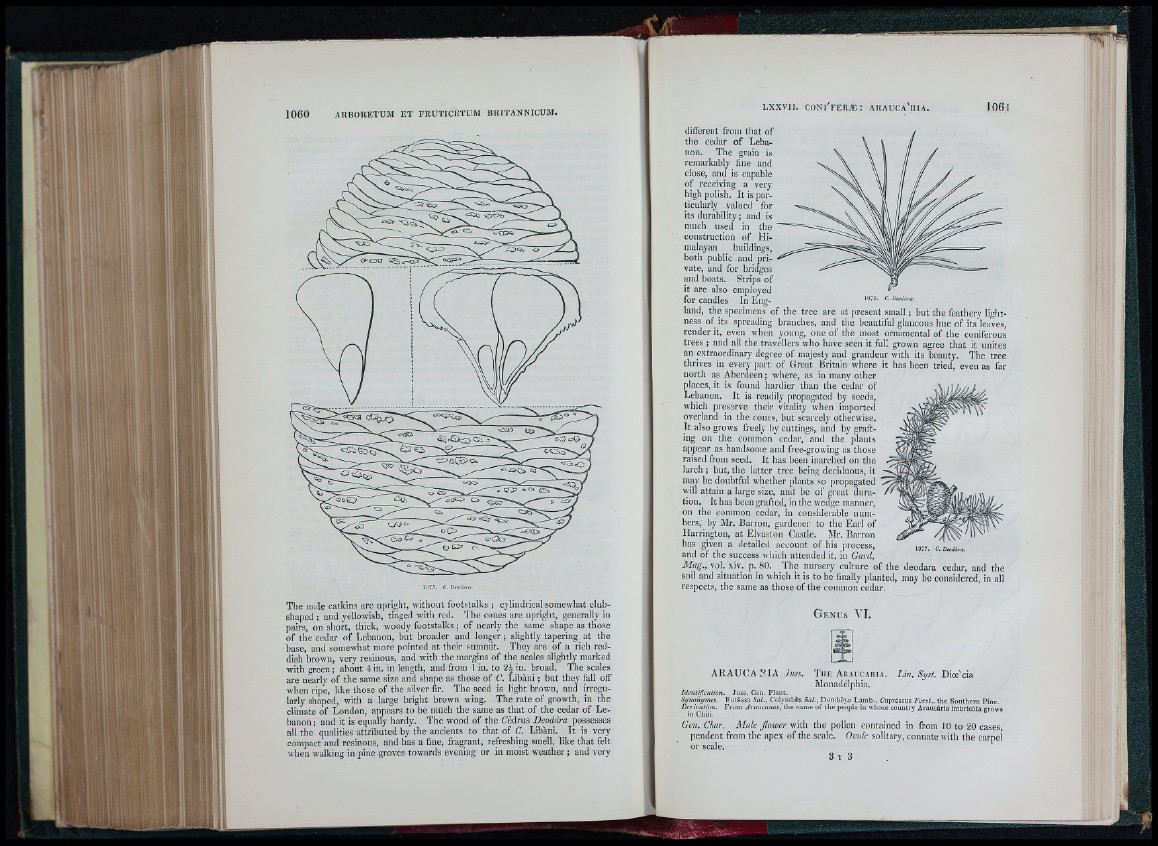
S W T
1975. C. Dtadàni
The mille catkins are upright, without footstalks ; cylindrical somewhat club-
shaped ; and yellowish, tinged with red. The cones are upright, generally in
pairs, on short, thick, woody footstalks ; of nearly the same shape as those
of the cedar of Lebanon, but broader and longer ; slightly tapering at the
base, and somewhat more pointed at their summit. They are of a rich reddish
brown, very resinous, and with the margins of the scales slightly marked
with green; about 4 in. in length, and from I in. to 2J in. broad. The scales
are nearly of the same size and shape as those o f C. Libàni ; but they fall off
when ripe, like those of the silver fir. The seed is light brown, and irregularly
shaped, with a large bright brown wing. The rate of growth, in the
climate of London, appears to be much the same as that of the cedar of Lebanon
; and it is equally hardy. The wood of the Cèdrus Deodàra possesses
all the qualities attributed by the ancients to that of C. Libàni. I t is very
compact and resinous, and has a fine, fragrant, refreshing smell, like that felt
when walking in pine groves towards evening or in moist weather ; and very
197G. C. Deodà
different from tliat of
the cedar o f Lebanon.
The grain is
remarkably fine and
close, and is capable
of receiving a very
high polish. It is particularly
valued for
its durability; and is
much used in the '
construction of Himalayan
buildings,
both public and private,
and for bridges
and boats. Strips of
it are also employed
for candles In England,
the specimens of the tree are at present small; but the feathery lightness
of its spreading branches, and the beautiful glaucous hue of its leaves,
render it, even when young, one of the most ornamental of the coniferous
trees ; and all the travellers who have seen it full grown agree that it unites
an extraordinary degree of majesty and grandeur with its beauty. The tree
thrives in every part of Great Britain where it has been tried, even as far
north as Aberdeen; where, as in many other
places, it is found hardier than the cedar of
Lebanon. It is readily propagated by seeds,
which pressrve their vitality when imported
overland in the cones, but scarcely otherwise.
Tt also grows ireely by cuttings, and by grafting
on the common cedar, and the plants
appear as handsome and fiee-growing as those
raised from seed. It has been iniU'ched on the
larch ; but, the latter tree being deciduous, it
may be doubtful whether plants so propagated
vyill attain a large size, and be of great duration.
It has been grafted, in the wedge manner,
on the common cedar, in considerable numbers,
by Mr. Barron, gardener to the Earl of
Harrington, at Elvaston Castle. Mr. Barron
has given a detailed account of his process,
and of the success which attended it, in Gard.
Mag., vol, xiv. p. 80. The nursery culture of the deodara cedar, and the
soil and situation in whicli it is to be finally planted, may be considered, in all
respects, the same as those of the common cedar.
G e n u s VI.
I'!.
1977. C. Deodàìa.
ARAUCA F IA Juss.
Identification. Juss. Gen. Plant.
T h e A r a u c a r ia .
Monadélphia.
Lin. Syst. Dice'cia
Synonymes. Eutâssa Sal., Colymbèa Sal., Dombèy« Lamb., Cupréssus Forst., the Southern Pine.
Derivation. From Araucanos, the name of the people in whose country Araucaria imbricàta grows
in Chili.
Gen, Char. Male fiower with the pollen contained in from 10 to 20 cases,
pendent from the apex of the scale. Ovule solitary, connate with the cai-pel
or scale.